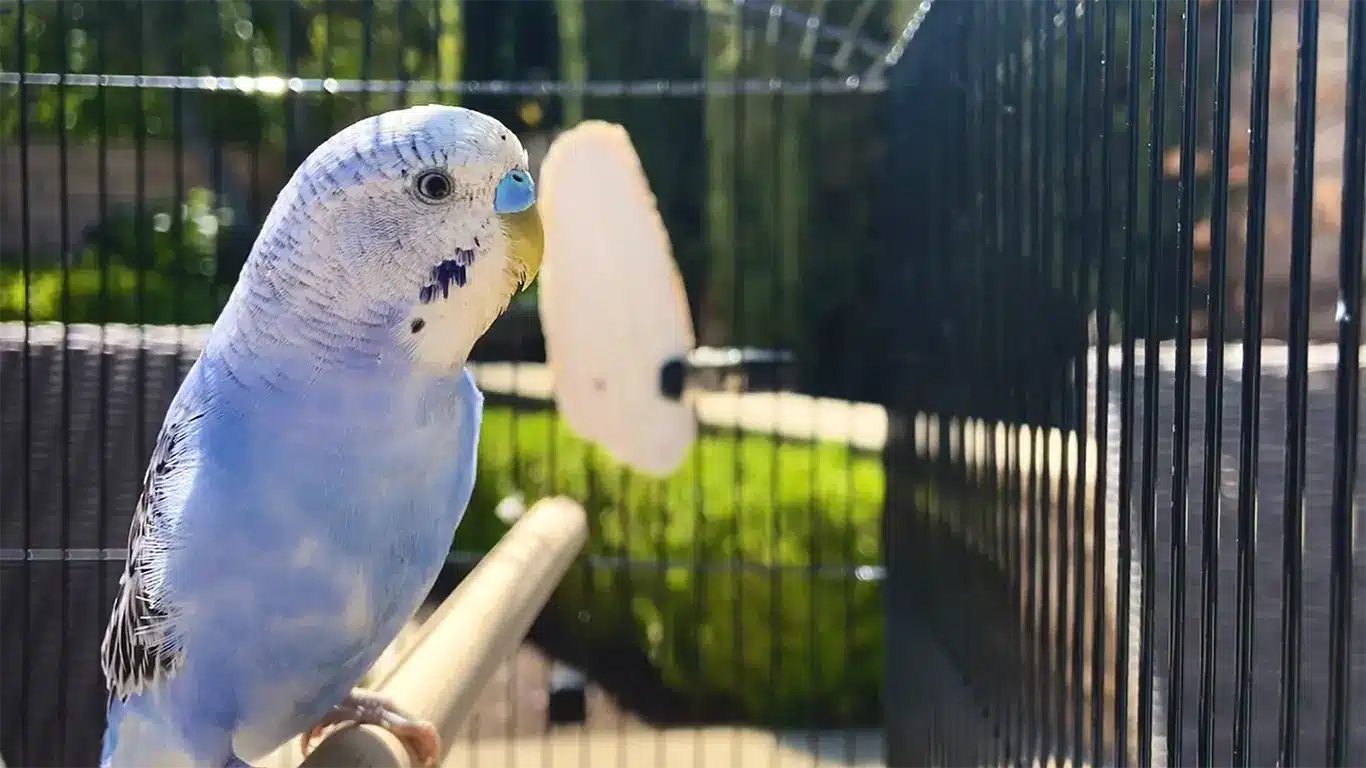You’re all set to welcome a chirpy budgie into your home, and now it’s time for one of the most essential preparations: finding the perfect cage. So, how do you choose the right budgie cage?
When choosing a budgie cage, prioritize size, ensuring it’s spacious enough for flight. Look for horizontal bars for climbing, and a pull-out tray for cleaning, and consider bar spacing (no wider than 1/2 inch) to prevent escape or injury.
1. Space and Size Matters
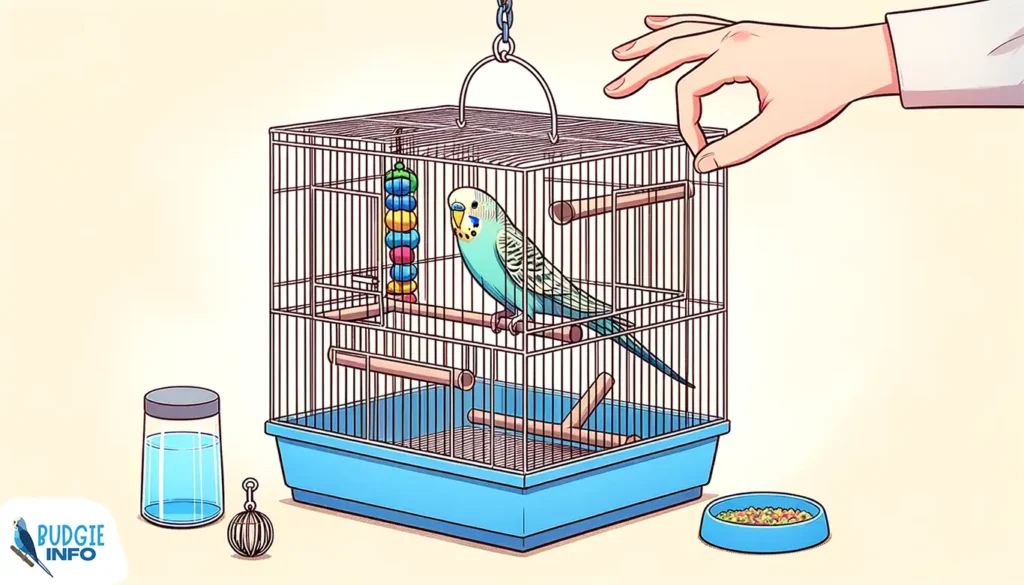
You wouldn’t like living in a cramped room with no space to stretch, right? Neither would your budgie. So when it comes to their living quarters, size is a big deal.
If you’re planning to get one budgie? Go for a cage that’s about 18×18×18 inches. Thinking of two budgies? A 30×18×18 inches cage should do. And for three budgies? Look for a cage around 32×18×20 inches. Easy enough!
| Number of Budgies | Recommended Cage Size (in inches) | Recommended Cage Size (in cm) |
| Single Budgie | 18×18×18 | 45.7×45.7×45.7 |
| Double Budgie | 30×18×18 | 76.2×45.7×45.7 |
| Triple Budgie | 32×18×20 | 81.3×45.7×50.8 |
Budgies, despite their compact size, love to fly. In the wild, they’d be zooming left and right, not just up and down. Their average wingspan is between 10 to 12 inches, which means they require a good deal of horizontal space to enjoy those flying stints.
Always choose width over height. While tall cages might seem like they offer more room, budgies benefit far more from the space that lets them fly side to side.
Remember, don’t be fooled by cages labeled ‘bird cages’ without specific measurements. Some cages might be too narrow, restricting the flying space essential for your budgie’s well-being.
2. Safety Considerations
With the cage’s size sorted, next comes the part where you ensure your Budgie’s new home is safe and secure. Let’s start with those cage bars. They need to be spaced just right – around 12mm (or half an inch for those who prefer imperial). This prevents your curious budgie from attempting to squeeze through or, worse, getting stuck.
I’ve properly written an article about Budgie Care. Make sure to check this out!
Materials play a pivotal role too. A cage might look flashy and stylish, but is it safe for your budgie? I want to give a bit of warning here: beware of cages made with lead or zinc. These materials can be harmful, even toxic, to birds.
Instead, go for cages made of powder-coated or stainless steel. Not only do they last longer, but they’re also budgie-safe.
Tip: Before making the purchase, give that cage a hands-on inspection. Feel around for any sharp edges or points that might harm your budgie.
3. Ease of Cleaning
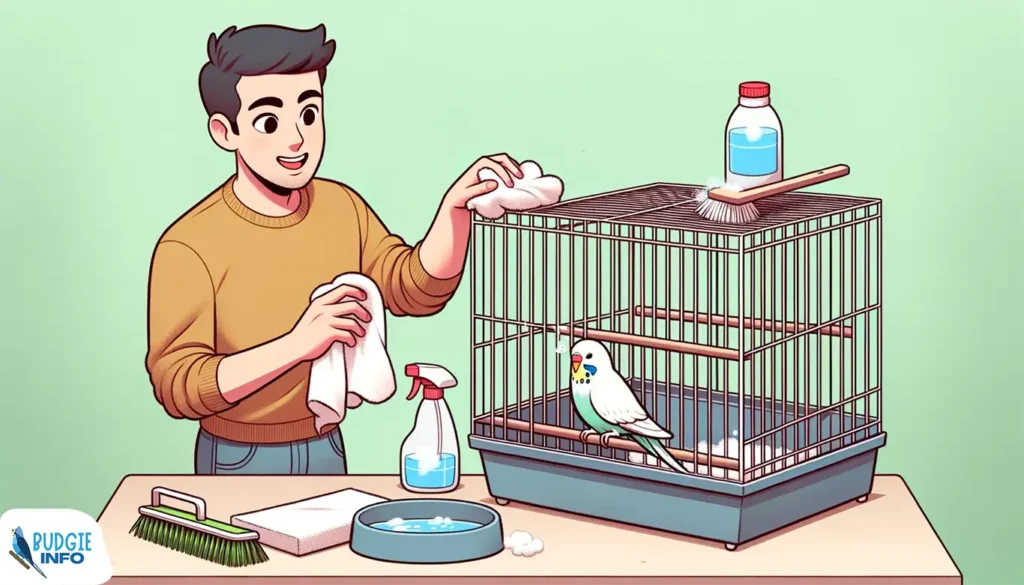
Let’s be real: as much as we love our cutest pet budgie, cleaning up after them can sometimes be a…well, messy affair. And that’s okay because their joy and company are absolutely worth it. But what if you could make that task a tad easier?
Removable Trays and Non-Porous Materials
You know what’s a total lifesaver? Those removable trays. These trays catch droppings, feathers, and any food that might not have made it to their little beaks. Simply slide it out, dump the mess, wipe it down, and slide it back in. There you have it, no hassle at all!
When choosing the budgie cage material, look for non-porous options. These materials don’t absorb or retain moisture, which means no stubborn stains or unpleasant odors. Plus, they’re super easy to wipe down.
Larger Doors Offer More Than Access
A larger door does more than just allow your budgie to hop in and out. It gives you easier access when it’s cleaning time. Think about it: no more trying to awkwardly reach that far corner with a cleaning brush. With more significant access points, cleaning down their space becomes effortless.
Did you know that to keep our budgies in top-notch health, their cages should be lightly cleaned daily and given a thorough scrub-down once a week? It might sound like much, but with the right cage setup, it’ll be smooth sailing.
Tip: Want to simplify the cleaning process even further? Consider lining the cage tray with newspapers or cage liners. When it's cleaning time, roll it up and toss it out.
4. Necessary Features
Now that we’ve covered the ins and outs of keeping that cage neat and clean, let’s talk about decking it out. Just like you’d want comfy furniture and essential appliances in your home, there are must-haves for your budgie’s cage.
The Essentials: From Perches to Dishes
At the top of the list? Perches. Budgies need places to rest, play, and observe their surroundings. Then, you’ve got food and water dishes – because, well, we all need to eat and drink. And don’t forget about secure locks. Remember what we said about budgies being little escape artists? Trust us; a secure lock is a must.
Variety Is The Spice Of Life… And Healthy Feet
Here’s something you might not know: using perches of varying sizes is excellent for your budgie’s foot health. It helps them exercise different parts of their feet, ensuring they stay nimble and pain-free.
Here’s a Perch type at a glance:
| Type | Advantages | Disadvantages |
| Wood | Natural, helps wear down nails, comfortable | Can be hard to clean |
| Rope | Soft, easy on feet, can be shaped | May fray, potential ingestion risk |
| Plastic | Easy to clean, durable | Not as natural, less grip |
One type of perch to steer clear from? Sandpaper perches. They might sound like a great idea for naturally filing down nails, but in reality, they can be abrasive and harmful to your budgie’s delicate feet.
5. Additional Amenities for a Happy Budgie
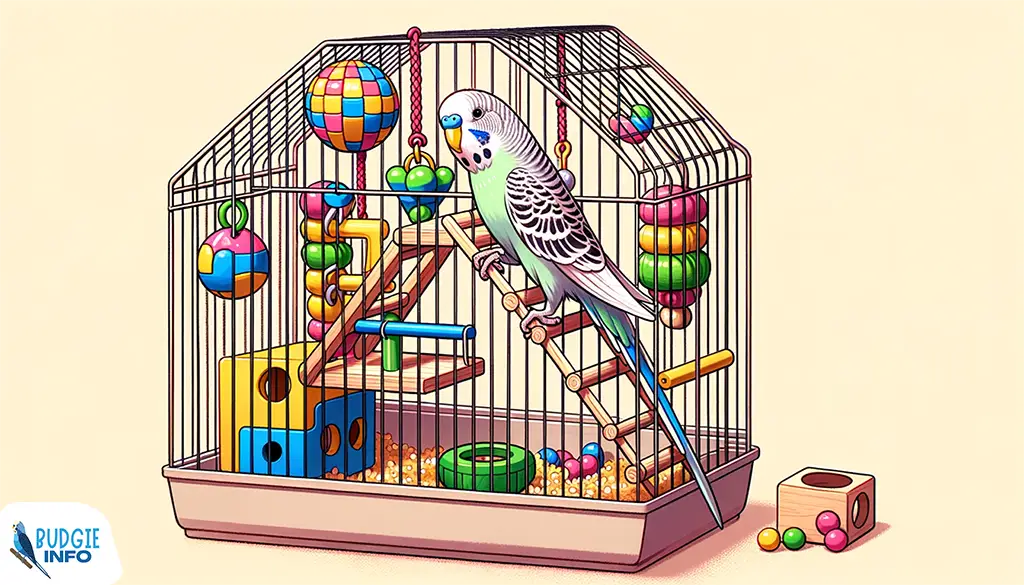
If you’ve ever watched a budgie in full play mode, you know how delightful and entertaining it can be. Just like humans, these little fellows thrive on stimulation and variety. Let’s make their space not just a cage but a playground.
Toys, Swings, and Ladders: More Than Just Decor
Toys are more than just cute additions to your budgie’s space; they’re essential for their mental and physical well-being. From bells and mirrors to chew toys made of safe wood or rope, the options are endless. And don’t forget swings and ladders! They’re like the jungle gyms of the budgie world, offering hours of fun and exercise.
But here’s a little heads-up: Budgies are intelligent creatures. They get bored with the same toys after a while. So, to keep their environment stimulating, rotate their toys regularly.
When shopping for toys, always ensure they’re budgie-safe. Keep an eye out for toys without small parts that can come off and be swallowed, and opt for materials that are non-toxic and safe to chew on.
6. Common Mistakes to Avoid When Choosing a Budgie Cage
Choosing a cage can be overwhelming, especially with all the adorable designs and styles flooding the market. But sometimes, what looks good might not be the best choice for our budgie buddies. Let’s steer clear of these pitfalls.
Size and Style: Function Over Form
It’s easy to pick a cute cage that looks good in your room. But remember, it’s more important to choose what’s best for your budgie. The most common mistake? Settling for a cage that’s too small. Keep in mind that, bigger is almost always better. Budgies need space to spread their wings, play, and move around.
When it comes to cage design, super fancy ones can be hard to clean. Those tiny spaces might look nice, but they can trap dirt and bird mess.
Location, Location, Location!
Once you’ve got that perfect cage, be mindful of where you place it. Avoid areas with direct sunlight, which can make the cage too hot. Similarly, drafty spots near windows or doors can make your budgie uncomfortably chilly.
Before committing to a cage, spend some time researching and reading reviews. Fellow budgie owners’ insights can be invaluable, helping you dodge potential pitfalls and ensuring you get the best cage for your budgie friend.
Final Words
Picking the perfect cage for your budgie involves considering its size (always lean towards spacious!), ensuring it’s safe from any tiny gaps or harmful materials, and of course, keeping an eye out for easy-to-clean features. On top of that, it’s all about those essential items like varying perches and dishes, not to mention the fun toys and swings to keep your budgie chirping happily.
FAQs About Choosing the Right Budgie Cage
Should Budgies Have Vertical Or Horizontal Cages?
Horizontal is the way to go. Budgies fly side-to-side, not up and down. A horizontal cage allows for more natural flight patterns and exercise. Give your budgie the room to spread those wings and soar.
Do Budgies Need Tall Or Wide Cages?
Wide is the winner. Budgies love flying side-to-side more than up-and-down. A wide cage gives them space for those horizontal flights, making for one happy bird.
Do Budgies Like Big Or Small Cages?
Big is better. Budgies cherish space to fly, play, and explore. The more room, the merrier! Ensure it’s secure and safe, but when in doubt, always lean towards giving them more space to flutter and have fun.
What Is A Cage Size For 2 Budgies In Cm?
At least 60cm wide x 40cm deep x 40cm high. This gives both birds space to move, fly, and play. But remember, bigger is often better! Ensure they’ve got room to stretch their wings and zip around together.
Where To Put Budgie When Cleaning The Cage?
Use a temporary cage or a safe room. If you have a second smaller cage, that’s ideal. If not, a budgie-proof room where they can fly safely without dangers (like open windows) works great.
What Budgie Cage Size Would Be Correct For One Budgie?
A minimum of 45cm wide x 35cm deep x 35cm high. But remember, bigger often means happier for your budgie! More space allows for better flight and play, making for one joyful bird.
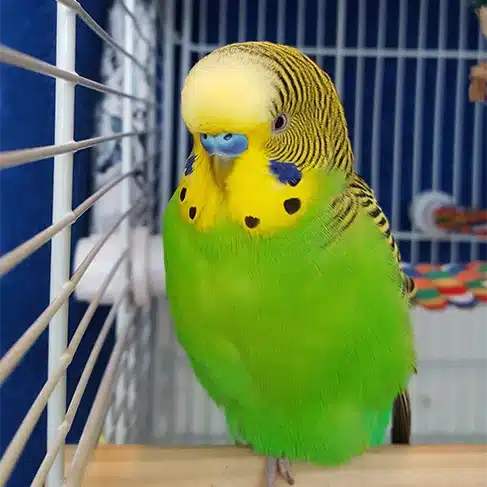
I’m Shajid Rahman, a happy owner of 6 beautiful budgies. I take care of this website to share tips, fun facts, and care guides about these birds.
Whether you’re a budgie lover or considering one as a pet, you’ll find helpful info here! I love these cute creatures, so I made this blog for Budgerigar fans. You can expect to get reliable information based on my years of experience. More About Me →

